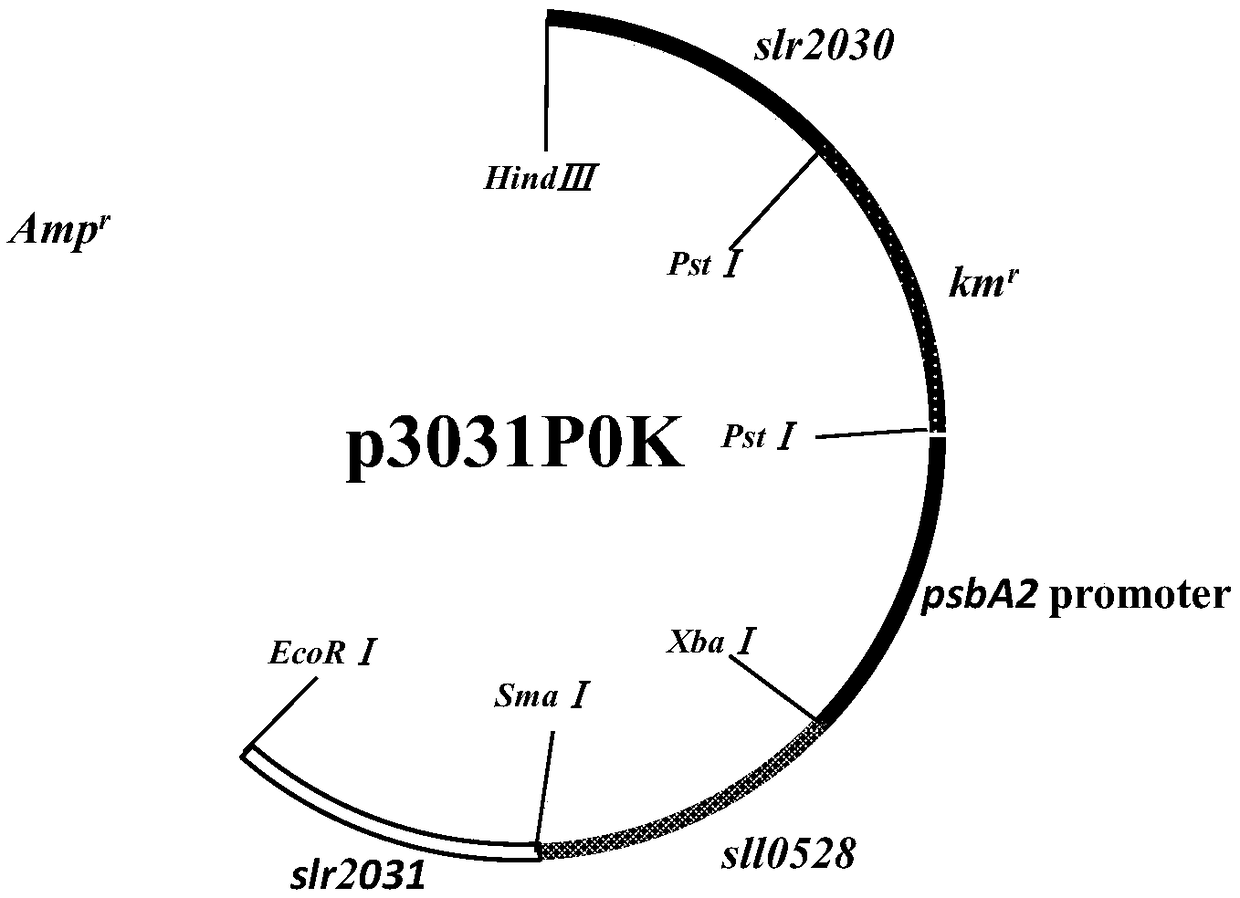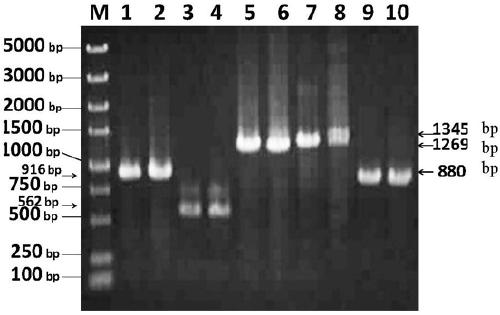Method for improving ammonium salt tolerance of synechocystis PCC6803 and application
A technology of PCC6803 and Synechocystis, which is applied in the field of improving the high-concentration ammonium salt tolerance of Synechocystis PCC6803, and achieves the effect of wide application prospect and improved tolerance.
- Summary
- Abstract
- Description
- Claims
- Application Information
AI Technical Summary
Problems solved by technology
Method used
Image
Examples
Embodiment 1
[0026] The construction of the recombinant plasmid p3031P0K includes the amplification of the target gene fragment, the enzyme-cut link between the target gene segment and the vector plasmid, and the identification of the recombinant plasmid.
[0027] Use the primer pair SEQ ID NO.1 and SEQ ID NO.2 in the sequence table, and use the Synechocystis PCC6803 wild-type genomic DNA (bacterial genome extraction kit) as a template to amplify the slr2030 fragment by PCR. The fragment sequence is as shown in SEQ ID NO .15 shown. At the same time, the target fragment slr2030 and the vector plasmid pUC118 were cut with restriction endonucleases HindⅢ and PstⅠ, and then the target fragment slr2030 and the vector plasmid pUC118 were connected with ligase to form the recombinant plasmid pUC118-2030. The recombinant plasmid pUC118-2030 was introduced into competent Escherichia coli DH10B for replication, and the Escherichia coli was grown in solid medium and liquid medium successively for 16h...
Embodiment 2
[0033] Obtaining the overexpression algae strain OE0528 includes the homologous double exchange between the recombinant plasmid p3031POK and the wild-type genome of Synechocystis sp. PCC6803, and the screening of the overexpression algae strain OE0528.
[0034] The constructed recombinant plasmid p3031P0K was mixed with the wild-type Synechocystis sp. PCC6803, cultivated in a shaker for 6h, and then spread on the solid BG11 medium covered with mixed fiber filter membrane. After 24h, the mixed fiber membrane was transferred to a medium containing 10 μg / mL kanamycin on the solid BG11 medium, the solid BG11 medium is placed in a light incubator, and after a few weeks, the medium grows a single algae colony, which is the transformant. In this process, the recombinant plasmid p3031P0K enters the wild-type Synechocystis sp. PCC6803, performs homologous double exchange with the help of homology arms slr2030 and slr2031, and overexpresses the element km r +psbA2 promoter+sll0528 inse...
Embodiment 3
[0040] Cultivation of Synechocystis sp. PCC6803 wild type and overexpressed strain OE0528 under high concentration ammonium salt stress.
[0041] by OD 730 = 0.1 as the initial concentration, the wild-type Synechocystis sp. PCC6803 and the overexpressed algae strain OE0528 were respectively inserted into the BG11 liquid medium containing ammonium chloride concentrations of 0 mM, 120 mM, 150 mM, 180 mM, and 210 mM. -2 ·s -1 , temperature 29 ℃, rotating speed 150r / min shaker for 5 days, measure OD every 24h 730 Value, draw the growth curve, and measure the 800nm ~ 400nm wavelength scanning absorption value until the 5th day of culture, and draw the whole cell absorption map.
[0042] Figure 5It is a growth curve graph, in which it can be observed that as the concentration of ammonium chloride increases gradually, the growth rate of WT gradually slows down, especially under the conditions of 180mM and 210mM ammonium chloride, the growth of WT is severely restricted. Howe...
PUM
 Login to View More
Login to View More Abstract
Description
Claims
Application Information
 Login to View More
Login to View More - R&D
- Intellectual Property
- Life Sciences
- Materials
- Tech Scout
- Unparalleled Data Quality
- Higher Quality Content
- 60% Fewer Hallucinations
Browse by: Latest US Patents, China's latest patents, Technical Efficacy Thesaurus, Application Domain, Technology Topic, Popular Technical Reports.
© 2025 PatSnap. All rights reserved.Legal|Privacy policy|Modern Slavery Act Transparency Statement|Sitemap|About US| Contact US: help@patsnap.com



